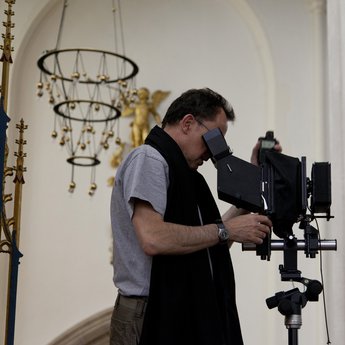
11-10-24
Shannon Ghannam, PMF Director of Development and Programming interviewed in the British Journal of Photography
11.10.24
This article was first printed in the British Journal of Photography Issue 7918.
Following Peter Marlow's death in 2016, a foundation was set up to further his passion for visual education via schemes for young people. Philippa Kelly speaks to PMF's Director of Development and Programming Shannon Ghannam.
A little over eight years ago, aged just 64, Magnum Photos photographer Peter Marlow died from influenza, contracted during a stem cell transplant as part of treatment for bone marrow cancer. At the time, the renowned photo agency told BJP he had been "part of the essential glue that has held us all together". In an obituary for The Guardian, critic Sean O'Hagan described him as "one of Britain's most respected photographers". For Shannon Ghannam, it was Marlow's industrious nature and considered approach to photography that had made him such.
Ghannam first met Marlow around 11 years before his death. Newly arrived in England from Australia, she was working at Magnum Photos as a keyworder, while Marlow and his partner Fiona Naylor were redesigning the agency's London HQ. "He was constantly in and out of the office, quietly getting things done," she recalls. "He was exacting and rigorous in all of his work."
By 2016 Ghannam's role at Magnum had grown to Global Education Director and, after Marlow's death, she began helping the photographer's family consider his legacy. Their conversations quickly crystallised into two clear aims. “Peter was keenly aware that the arts and photography were being offered less in the state curriculum, and he was passionate about young people having access to a visual education," Ghannam says. "Fiona saw that the power of visual storytelling and a shared interest could bring people from disparate backgrounds together, and help them find common ground, connection and community."
These issues became the core focus of the Peter Marlow Foundation, where Ghannam now works as Director of Development and Programming. Launched in 2018, the organisation is designed to celebrate and examine humanist photography, alongside its impact and its legacy. Pending planning permission, the foundation will soon open a new home in Dungeness, Kent, housing an extensive archive of Marlow's work plus a library, gallery and darkroom. The space will also offer workshops, exhibitions, residencies and talks to schools, the public and professionals.
These activities draw their inspiration from Marlow's photographs, and his distinctive approach to making them. Beginning his career as a cruise ship photographer - a role he secured by presenting a friend's portfolio as his own - by 1976 he had joined photo-news agency, Sygma. Marlow was successful as a conflict photographer, but his time in Northern Ireland and Lebanon left him questioning the ethics of his work. "The stereotype of the concerned photojournalist disguised the disheartening reality of dog-eat-dog competition between photographers hunting fame at all costs," he famously wrote of this period of his career.
In 1980 Marlow joined Magnum Photos, and his work began to shift in style and tone. He started to introduce more colour, to focus on longer-term documentary projects, and made portraits of leading political figures. During the mid-1980s he photographed regularly for The Sunday Times, and in the following decade documented soon-to-be prime minister Tony Blair during the rise of New Labour.
Marlow's personal projects saw him collaborate with fellow Magnum photographer Chris Steele-Perkins to chronicle the rise of the right wing in the late 1970s, and create a long-term study of Liverpool in the 1980s. This work, which captured inner-city communities fighting to survive the impact of Thatcherite government policy, became perhaps his best-known and most celebrated. However, a contemplative and considered approach to image-making underpins all of Marlow's photography - qualities which can also be seen in his foundation's pilot projects.
Following Peter Marlow's death in 2016, a foundation was set up to further his passion for visual education via schemes for young people. Philippa Kelly speaks to PMF's Director of Development and Programming Shannon Ghannam.
A little over eight years ago, aged just 64, Magnum Photos photographer Peter Marlow died from influenza, contracted during a stem cell transplant as part of treatment for bone marrow cancer. At the time, the renowned photo agency told BJP he had been "part of the essential glue that has held us all together". In an obituary for The Guardian, critic Sean O'Hagan described him as "one of Britain's most respected photographers". For Shannon Ghannam, it was Marlow's industrious nature and considered approach to photography that had made him such.
Ghannam first met Marlow around 11 years before his death. Newly arrived in England from Australia, she was working at Magnum Photos as a keyworder, while Marlow and his partner Fiona Naylor were redesigning the agency's London HQ. "He was constantly in and out of the office, quietly getting things done," she recalls. "He was exacting and rigorous in all of his work."
By 2016 Ghannam's role at Magnum had grown to Global Education Director and, after Marlow's death, she began helping the photographer's family consider his legacy. Their conversations quickly crystallised into two clear aims. “Peter was keenly aware that the arts and photography were being offered less in the state curriculum, and he was passionate about young people having access to a visual education," Ghannam says. "Fiona saw that the power of visual storytelling and a shared interest could bring people from disparate backgrounds together, and help them find common ground, connection and community."
These issues became the core focus of the Peter Marlow Foundation, where Ghannam now works as Director of Development and Programming. Launched in 2018, the organisation is designed to celebrate and examine humanist photography, alongside its impact and its legacy. Pending planning permission, the foundation will soon open a new home in Dungeness, Kent, housing an extensive archive of Marlow's work plus a library, gallery and darkroom. The space will also offer workshops, exhibitions, residencies and talks to schools, the public and professionals.
These activities draw their inspiration from Marlow's photographs, and his distinctive approach to making them. Beginning his career as a cruise ship photographer - a role he secured by presenting a friend's portfolio as his own - by 1976 he had joined photo-news agency, Sygma. Marlow was successful as a conflict photographer, but his time in Northern Ireland and Lebanon left him questioning the ethics of his work. "The stereotype of the concerned photojournalist disguised the disheartening reality of dog-eat-dog competition between photographers hunting fame at all costs," he famously wrote of this period of his career.
In 1980 Marlow joined Magnum Photos, and his work began to shift in style and tone. He started to introduce more colour, to focus on longer-term documentary projects, and made portraits of leading political figures. During the mid-1980s he photographed regularly for The Sunday Times, and in the following decade documented soon-to-be prime minister Tony Blair during the rise of New Labour.
Marlow's personal projects saw him collaborate with fellow Magnum photographer Chris Steele-Perkins to chronicle the rise of the right wing in the late 1970s, and create a long-term study of Liverpool in the 1980s. This work, which captured inner-city communities fighting to survive the impact of Thatcherite government policy, became perhaps his best-known and most celebrated. However, a contemplative and considered approach to image-making underpins all of Marlow's photography - qualities which can also be seen in his foundation's pilot projects.
The first of these, Hastings Youth Press, was born from a collaboration with newspaper Hastings Independent and the Magnum Photos Foundation. The partnership delivered a free multimedia journalism training programme to a group of local youngsters from backgrounds under-represented in the media, culminating in an exhibition exploring their experiences of life in the town. "The project provided me with a creative and intellectual space where I felt genuinely valued and respected," explains Samara Jayne Martin, who took part in the pilot. "It played a pivotal role in my journey of self-discovery, particularly in exploring my neurodiversity."
For Ghannam, the importance of this particular work is two-fold. She moved to the south-east coast - where Hastings and Dungeness, the home of the Peter Marlow Foundation, are - from London during the Covid-19 pandemic, and quickly fell in love with the seaside. She describes becoming part of this community as serendipitous, given that it now plays a pivotal role in the foundation's projects, all of which are co-created with local grassroots organisations. "The idea of legacy or accountability around a project takes on a whole new meaning when you know you will run into partners or participants on the street or in the local shop for the rest of your life,” she says. "We'd better be building something we can all see ourselves in, that we can all be proud of, something that means something, something transformational." Ghannam goes on to acknowledge the time and investment required to achieve such goals, and to reassert her commitment to them - one developed, in part, from her own experiences.
Growing up in social housing in the sprawling Brisbane suburbs, Ghannam had no access to galleries or to meaningful journalism. She discovered black-and-white photography during secondary school, and found the process meditative, mysterious - and life-changing. She recalls how being able to read and borrow photobooks during these formative years opened a new world up to her, and set her on the path to become the first member of her family to attend university. When she left, a friend helped secure her first job in photography. “It was a time when the photography industry was run on unpaid internships and that clearly limited who was able to consider a job in the arts," she recalls. "My experience, although a good one, also points to the nepotism that was rife."
These are valid and well-documented concerns. The number of UK creatives from working-class backgrounds has shrunk by half since the 1970s, while the number of journalists from professional and upper-class backgrounds sits at 80 per cent - 38 per cent higher than the rest of the general workforce.
For Ghannam, the importance of this particular work is two-fold. She moved to the south-east coast - where Hastings and Dungeness, the home of the Peter Marlow Foundation, are - from London during the Covid-19 pandemic, and quickly fell in love with the seaside. She describes becoming part of this community as serendipitous, given that it now plays a pivotal role in the foundation's projects, all of which are co-created with local grassroots organisations. "The idea of legacy or accountability around a project takes on a whole new meaning when you know you will run into partners or participants on the street or in the local shop for the rest of your life,” she says. "We'd better be building something we can all see ourselves in, that we can all be proud of, something that means something, something transformational." Ghannam goes on to acknowledge the time and investment required to achieve such goals, and to reassert her commitment to them - one developed, in part, from her own experiences.
Growing up in social housing in the sprawling Brisbane suburbs, Ghannam had no access to galleries or to meaningful journalism. She discovered black-and-white photography during secondary school, and found the process meditative, mysterious - and life-changing. She recalls how being able to read and borrow photobooks during these formative years opened a new world up to her, and set her on the path to become the first member of her family to attend university. When she left, a friend helped secure her first job in photography. “It was a time when the photography industry was run on unpaid internships and that clearly limited who was able to consider a job in the arts," she recalls. "My experience, although a good one, also points to the nepotism that was rife."
These are valid and well-documented concerns. The number of UK creatives from working-class backgrounds has shrunk by half since the 1970s, while the number of journalists from professional and upper-class backgrounds sits at 80 per cent - 38 per cent higher than the rest of the general workforce.
The recently commenced second phase of the Young Creatives Collective is another Peter Marlow Foundation effort to address this disparity in access and representation. Beginning as a mentorship programme for young people from asylum seeker, refugee and migrant backgrounds to explore their creativity and creative education, the project is now focusing on offering participants personalised further education and career guidance. Students take part in workshops and receive mentoring and CV advice, all while working on a publication and exhibition - which will be shown in Bexhill-on-Sea as part of De La Warr Pavilion's refugee week in June.
The foundation's work also stretches beyond the south coast - in London the second phase of Manor Park Media will soon get underway, following substantial funding from Foundation for Future London. Based in Newham, where over 40 per cent of residents are estimated to be living in poverty, the collaborative project has involved input from several charities and trusts, alongside young people experiencing multiple inequalities. Together they have produced a framework for youth workers and arts organisations to co-design programmes, helping youngsters unlock personalised progression pathways.
"One of the things that stands out for me from all of these projects is that moment when a young person shares the story they've been working on with an audience, and how powerful that can be," Ghannam reflects. "I think it addresses our basic human need to be seen, to be heard, to connect, to belong. I have understood from the young people we're working with what it feels like to not have that, and to see the change when they do is the reason I'm doing this work."
Ghannam goes on to discuss recent industry conversations she has witnessed through her work - opportunities to further evolve our understanding of the roles photography and storytelling play in our society. "For example, the way that photography was used to create powerful narratives around notions of race, class and gender, how they have been used, who they have served and the many narratives that were left out," she says.
Peter Marlow Foundation plans to contribute to these conversations by continuing to create opportunities throughout Kent and its bordering counties, as well as by playing its part in a growing creative and cultural ecosystem and economy. Ghannam acknowledges that this will not be easy - the arts' role in society has been undervalued across the UK for many years, making the funding landscape more competitive than ever. However, the foundation has succeeded in securing grants in the past, and with continued support from Magnum Photos' sales of Marlow's work, and from "generous" donors, she is positive about its future.
This future, Ghannam hopes, will become brighter still from 2025, when the foundation plans to open its new home in a World War Two building, the redesign of which is currently awaiting planning approval. "I love that we will be creating a community of people using the building," Ghannam says. "Whether that's a local school group using our photobook library, professional photographers using our darkroom, emerging photographers attending workshops or our residency photographers, emerging and established, working with each other and the local community."
These residency photographers will take part in the Peter Marlow Fellowship, which will be awarded to image-makers whose work continues Marlow's dedication to a humanistic approach. "In his lifetime Peter Marlow worked all over the world, and his ever-thoughtful photographs deal with close observation of the physical and personal landscape that is often overlooked," Ghannam says. "His lens was always on the human and social. The foundation will continue in this spirit, providing a focus on social realism and people, both in the work it shares and in the activity it generates."
The foundation's work also stretches beyond the south coast - in London the second phase of Manor Park Media will soon get underway, following substantial funding from Foundation for Future London. Based in Newham, where over 40 per cent of residents are estimated to be living in poverty, the collaborative project has involved input from several charities and trusts, alongside young people experiencing multiple inequalities. Together they have produced a framework for youth workers and arts organisations to co-design programmes, helping youngsters unlock personalised progression pathways.
"One of the things that stands out for me from all of these projects is that moment when a young person shares the story they've been working on with an audience, and how powerful that can be," Ghannam reflects. "I think it addresses our basic human need to be seen, to be heard, to connect, to belong. I have understood from the young people we're working with what it feels like to not have that, and to see the change when they do is the reason I'm doing this work."
Ghannam goes on to discuss recent industry conversations she has witnessed through her work - opportunities to further evolve our understanding of the roles photography and storytelling play in our society. "For example, the way that photography was used to create powerful narratives around notions of race, class and gender, how they have been used, who they have served and the many narratives that were left out," she says.
Peter Marlow Foundation plans to contribute to these conversations by continuing to create opportunities throughout Kent and its bordering counties, as well as by playing its part in a growing creative and cultural ecosystem and economy. Ghannam acknowledges that this will not be easy - the arts' role in society has been undervalued across the UK for many years, making the funding landscape more competitive than ever. However, the foundation has succeeded in securing grants in the past, and with continued support from Magnum Photos' sales of Marlow's work, and from "generous" donors, she is positive about its future.
This future, Ghannam hopes, will become brighter still from 2025, when the foundation plans to open its new home in a World War Two building, the redesign of which is currently awaiting planning approval. "I love that we will be creating a community of people using the building," Ghannam says. "Whether that's a local school group using our photobook library, professional photographers using our darkroom, emerging photographers attending workshops or our residency photographers, emerging and established, working with each other and the local community."
These residency photographers will take part in the Peter Marlow Fellowship, which will be awarded to image-makers whose work continues Marlow's dedication to a humanistic approach. "In his lifetime Peter Marlow worked all over the world, and his ever-thoughtful photographs deal with close observation of the physical and personal landscape that is often overlooked," Ghannam says. "His lens was always on the human and social. The foundation will continue in this spirit, providing a focus on social realism and people, both in the work it shares and in the activity it generates."
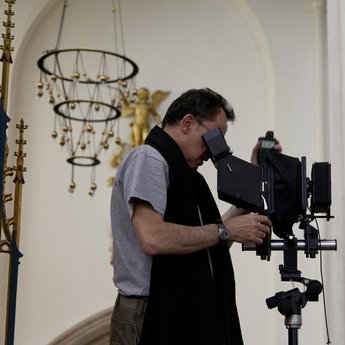
Peter Marlow photographing St Edmundsbury Cathedral, Suffolk, by Peter’s assistant, Marcio Suster, 2012 © Peter Marlow Foundation
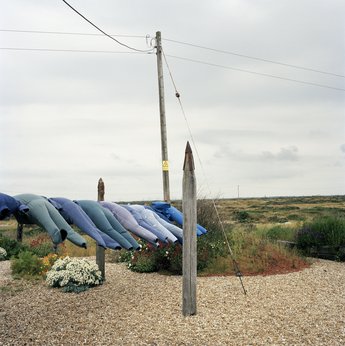
Overalls drying in Derek Jarman's garden in Dungeness. Kent, England. 2005. Peter Marlow © PETER MARLOW FOUNDATION
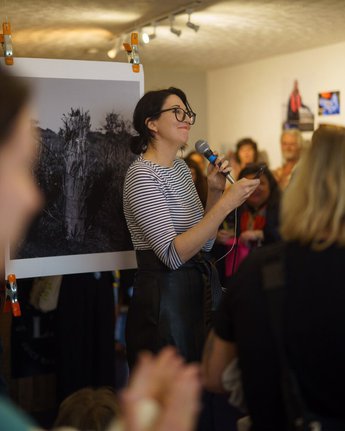
Shannon Ghannam speaks at the launch of Hastings Youth Press. East Sussex, England. 2023. © PETER MARLOW FOUNDATION
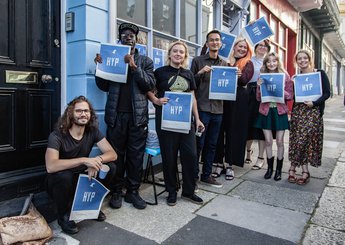
Hasting Youth Press Launch Event. East Sussex, England. 2023. Samara Jayne Martin
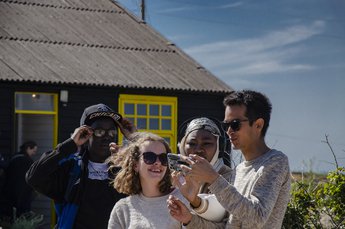
Young Creatives Collective and Hastings Youth Press visit Derek Jarman's cottage in Dungeness. Kent, England. Abraham O.

Manor Park Media Collective. Manor Park. Newham, England. © Manor Park Media Collective
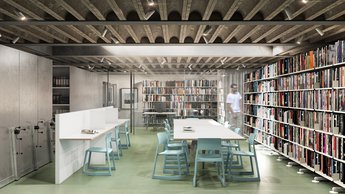
Planned Peter Marlow Foundation Library, Archive and Workshop Space. Computer Generated Image. © PETER MARLOW FOUNDATION

Peter Marlow photographing St Edmundsbury Cathedral, Suffolk, by Peter’s assistant, Marcio Suster, 2012 © Peter Marlow Foundation

Overalls drying in Derek Jarman's garden in Dungeness. Kent, England. 2005. Peter Marlow © PETER MARLOW FOUNDATION

Shannon Ghannam speaks at the launch of Hastings Youth Press. East Sussex, England. 2023. © PETER MARLOW FOUNDATION

Hasting Youth Press Launch Event. East Sussex, England. 2023. Samara Jayne Martin

Young Creatives Collective and Hastings Youth Press visit Derek Jarman's cottage in Dungeness. Kent, England. Abraham O.
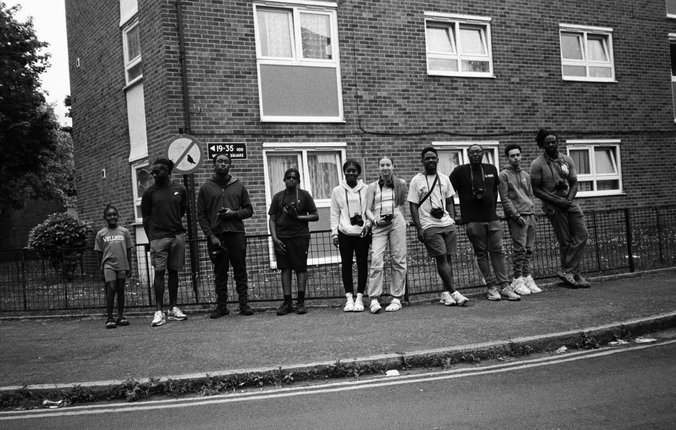
Manor Park Media Collective. Manor Park. Newham, England. © Manor Park Media Collective

Planned Peter Marlow Foundation Library, Archive and Workshop Space. Computer Generated Image. © PETER MARLOW FOUNDATION